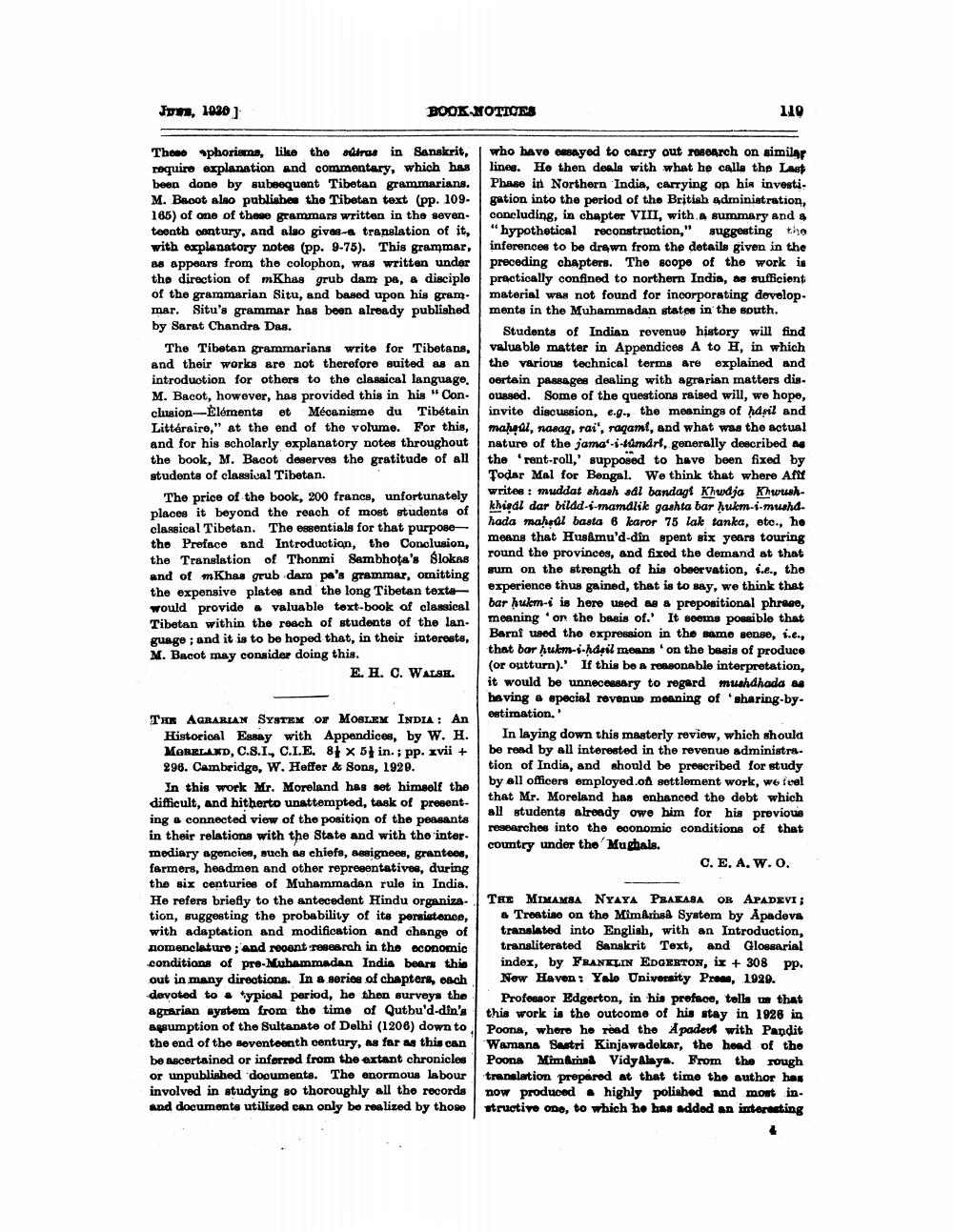________________
Jun, 1930 ]
BOOK NOTICES
110
Thono aphoriama, like the stras in Sanskrit, who have ensayed to carry out research on similar require explanation and commentary, which has lines. He then deals with what he calls thp Laut been done by subsequent Tibetan grammarians. Phase in Northern India, carrying on his investi. M. Bacot also publishes the Tibetan text (pp. 109. gation into the period of the British administration, 165) of one of these grammars written in the seven. concluding, in chapter VIII, with a summary and teenth century, and also gives a translation of it, "hypothetical reconstruction," suggesting the with explanatory notes (pp. 9-75). This grammar, inferences to be drawn from the details given in the as appears from the colophon, was written under | preceding chapters. The scope of the work is the direction of mKhas grub dam pa, a disciple practically confined to northern India, ae sufficient of the grammarian Situ, and based upon his gram. material was not found for incorporating develop. mar. Situ's grammar has been already published mente in the Muhammadan states in the south. by Sarat Chandra Das.
Students of Indian revenue history will find The Tibetan grammarians write for Tibetans, valuable matter in Appendices A to H, in which and their works are not therefore suited as an the various technical terms are explained and introduction for others to the classical language. certain passages dealing with agrarian matters dis. M. Bacot, however, has provided this in his "Con. ouaged. Some of the questions raised will, we hope, clusion--Eléments et Mécanisme du Tibétain invite discussion, c.9. the meanings of hdyil and Littéraire," at the end of the volume. For this, mahad, nasag, rai', raqami, and what was the actual and for his scholarly explanatory notes throughout nature of the jama-s-famdrl, generally described a the book, M. Bacot deserves the gratitude of all the 'rent-roll,' supposed to have been fixed by students of classical Tibetan.
Todar Mal for Bengal. We think that where Afit The price of the book, 200 francs, unfortunately
writes: muddat shash sál bandagi Khudja Khwushplaces it beyond the reach of most students of
khisal dar bildd-s-mamdlik gashta bar hukm-1-mushdclassical Tibetan. The essentials for that purpose
hada mahsul basta 6 karor 75 lake tanka, etc., ho the Preface and Introduction, the Conclusion,
means that Husamu'd-dîn spent six years touring the Translation of Thonmi Sambhota's Slokas
round the provinces, and fixed the demand at that
sum on the strength of his obeervation, s.e., the and of mKhas grub dam pa's grammar, omitting
experience thus gained, that is to say, we think that the expensive plates and the long Tibetan texte would provide evaluable toxt-book of classical
bar hukm-s is here used as a prepositional phrase, Tibetan within the reach of students of the lan
meaning on the basis of. It seerns possible that guage ; and it is to be hoped that, in their interests,
Barnf wed the expression in the same sense, 1.6., M. Bacot may consider doing this.
that bar hukm-1-hdpil means on the basis of produce
(or outturn). If this be a reasonable interpretation, E. F. C. WALSE.
it would be unnecessary to regard mushdhada as
having a special revenue meaning of sharing-byTER AGRARIAN SYSTEM OF MOSLEM INDIA: An
estimation.' Historical Essay with Appendices, by W. H. In laying down this masterly review, which should MORELAND, C.S.I., C.L.E. 81 x 51 in. ; pp. xvii + be read by all interested in the revenue administra296. Cambridge, W. Heffer & Sons, 1920.
tion of India, and should be prescribed for study In this work Mr. Moreland has set himself the
by all officers employed.on settlement work, we fuel difficult, and hitherto unattempted, task of present
that Mr. Moreland has enhanced the debt which ing a connected view of the position of the peasants
all students already owe him for his previous
researches into the economic conditions of that in their relations with the State and with the inter
country under the Mughals. modiary agencies, such as chiefs, assignees, grantes, farmers, headmon and other representatives, during
C.E.A.W.O. the six centuries of Muhammadan rule in India. He refers briefly to the antecedent Hindu organiza- THE MIMAMBA NYAYA PEAKASA OR APADEVI; tion, suggesting the probability of its persistence, & Treatise on the Mimarsd System by Apadeva with adaptation and modification and change of translated into English, with an Introduction, nomenclature ; and reoont research in the economic transliterated Sanskrit Text, and Glossarial conditions of pre-Muhammadan India bears this index, by FRANKLIN EDGERTON, Ix + 308 pp. out in many directions. In a series of chapters, each New Haven : Yale University Press, 1929. devoted to . ypical period, he then surveys the Profesor Edgerton, in his proface, tolla um that agrarian system from the time of Qutbu'd-din's this work is the outcome of his stay in 1926 in segumption of the Sultanate of Delhi (1206) down to Poona, where he read the padent with Pandit the end of the seventeenth century, as far as this can Wamana Sastri Kinjawadekar, the head of the be facertained or inferred from the axtant chronicles Poona Mimi Vidy Alaya. From the rough or unpublished doouments. The enormous labour translation prepared at that time the author hag involved in studying so thoroughly all the records now produced highly polished and most in. and documente utilized can only be realized by thomestructive ono, to which he has added an interesting




